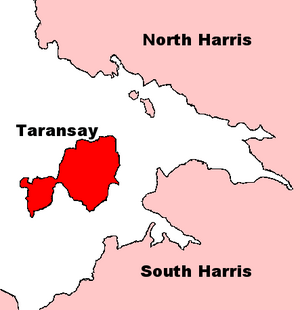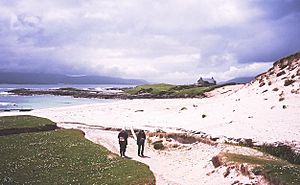Taransay facts for kids
| Norse name | Taransey |
|---|---|
| Meaning of name | Old Norse for 'Tara island' |
| OS grid reference | NB025013 |
| Coordinates | 57°54′00″N 7°01′01″W / 57.9°N 7.017°W |
| Physical geography | |
| Island group | Lewis and Harris |
| Area | 1,475 ha (5+3⁄4 sq mi) |
| Area rank | 38 |
| Highest elevation | Ben Raah 267 m (876 ft) |
| Administration | |
| Sovereign state | United Kingdom |
| Country | Scotland |
| Council area | Na h-Eileanan Siar |
| Demographics | |
| Population | Uninhabited since 1974 |
| Largest settlement | Paibeil |
Taransay (also known as Tarasaigh in Scottish Gaelic) is a beautiful island in the Outer Hebrides, Scotland. It became famous for hosting the British TV show Castaway 2000. Since 1974, no one has lived on Taransay permanently, except for people on holiday. It is the largest island in Scotland without a permanent population.
Contents
Exploring Taransay's Geography
Taransay is about 3 kilometers (1.8 miles) from Harris. A part of the sea called the Sound of Taransay separates them. Getting between the two islands depends on calm weather. There are no big harbors for large boats on either island. Taransay is about 6.4 kilometers (4 miles) long. At its widest point, it is about 5 kilometers (3.1 miles) across. The island covers an area of about 14.9 square kilometers (5.75 square miles).
The island has two hills covered in heather, each about 228 meters (750 feet) high. These hills are connected by a white sandy strip of land in the south. Taransay looks out over the bays of Luskyntyre and Seilibost to the east. The vast Atlantic Ocean is to its west. The bays have sandy beaches and grassy dunes called machair. The island's rocks are mostly gneiss, with some granite. The highest point is Ben Raah, which is 267 meters (876 feet) tall.
Wildlife and Nature on Taransay
Taransay is home to many different birds. Other animals like red deer and mice also live there. In 2003 and 2004, a project worked to remove American mink from the island. This was done to protect rare ground-nesting birds. Taransay is also known for its many wildflowers. These flowers grow in the island's machair grasslands.
A Look at Taransay's History
People have lived on Taransay since at least 300 AD, and probably even earlier. The first people were Celtic pagans. Christianity came to Taransay around 650 AD. In 900 AD, Vikings took over Taransay when they invaded Scotland.
In 1544, a sad event called the Massacre of Taransay happened. The Morrisons from Lewis attacked the island. People from the nearby island of Berneray fought back. They forced the Morrisons to a rock where they were executed. This rock was later named Sgeir Bhuailte, meaning "smitten rock."
In 1549, a writer named Donald Monro described Taransay. He said it was a rough island, but well-inhabited and farmed. He noted that most of the farming was done with spades. Even so, the island had plenty of barley, corn, livestock, and good fishing.
Past Villages and Population Changes
Taransay once had three villages: Raa, Uidh, and Paible (Paibeil). In 1835, rent prices went up, causing many people to leave Taransay. Things got worse in 1883 when new rules stopped small farmers (called cotters) from keeping animals or growing oats and barley. The island was left empty in 1942 but people moved back later. By 1961, only one family, the MacRaes, lived in Paible. They left in 1974, and Taransay became uninhabited again. For many years, the island was used as a sheep farm, managed from the Harris mainland.
The island's name itself tells us about its past. "Taransay" comes from Old Norse, meaning "the Isle of Taran." It was likely named after an Irish saint called Saint Ternan. Another idea is that Taran might have been the son of a noble Pictish family.
The village of Paible had two old chapels. One was for Saint Taran and the other for Saint Keith. Women were buried at Saint Taran's chapel, and men at Saint Keith's. An old island story says that if this rule was broken, the dead would rise. Today, you can still see the remains of Saint Keith's chapel. However, Saint Taran's chapel was destroyed by the sea in the late 1970s.
In 1967, John MacKay bought the island for £11,000. In 2011, his sons, Angus and Norman MacKay, put the island up for sale for £2.2 million. Ben Fogle, a TV presenter who visited Taransay after Castaway, wanted to buy it to create a wildlife reserve. However, he was not successful. The island was sold to a local family within two weeks.
Taransay and the Castaway TV Show
Taransay became very famous because of the BBC show Castaway. The show featured 36 people who lived on the island for a whole year, starting on January 1, 2000. Castaway was shown in many countries around the world. At its most popular, nine million people watched the show. The people on the show were volunteers chosen from 4,000 applicants.
They lived in special temporary homes called 'pods' in the old village of Paible. Other buildings, like a farmhouse and a school chalet, were fixed up for the show. Since 2004, these buildings have been available as holiday cottages for tourists. The BBC said the project aimed to "create a new society for the new millennium."
Unlike the island's original residents, the "castaways" had electricity and water. They also had some modern comforts. Out of the 36 people who started the show, 29 stayed for the entire year. This included Ben Fogle, who later became a well-known BBC presenter. The show was seen as a social experiment. It explored how this group of people would form a community.
After the Castaway show ended in 2001, the 'pods' were taken apart. They were moved to other places in Scotland, like the island of Muck. Since then, Taransay has been a place for tourists. The buildings are rented out as holiday homes, and boat trips take visitors to the island.
Castaway 2007 was a similar show, but it took place on a much warmer island called Great Barrier Island in New Zealand.
The Rocket Post Film
A movie called The Rocket Post was filmed on Taransay in 2001. This film tells a made-up story about a real experiment from 1934. A German inventor named Gerhard Zucker tried to deliver mail to the island of Scarp using rockets.
|
See also
 In Spanish: Taransay para niños
In Spanish: Taransay para niños




